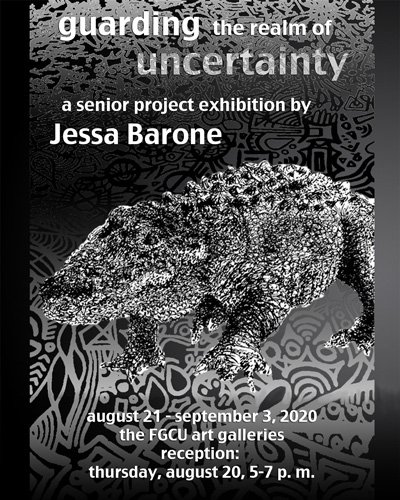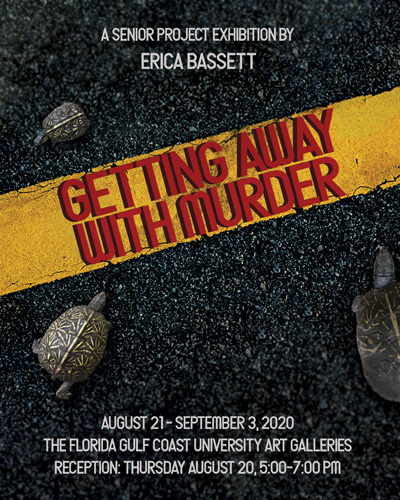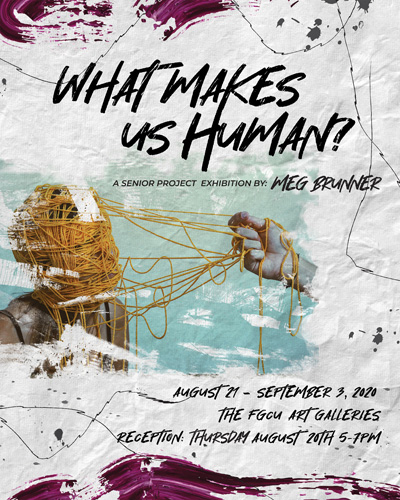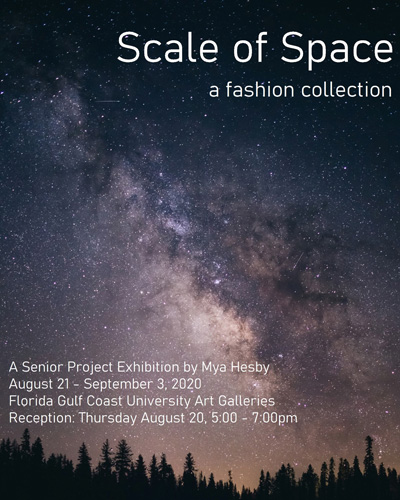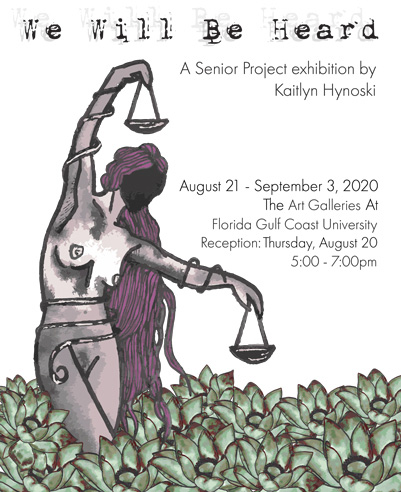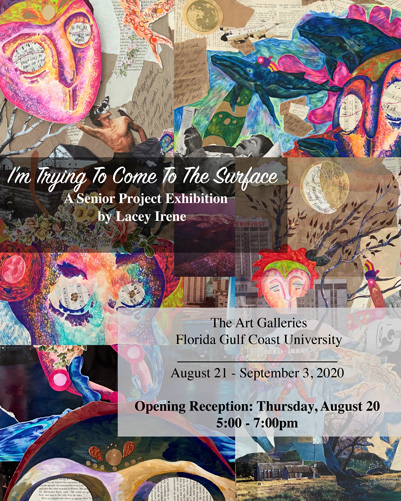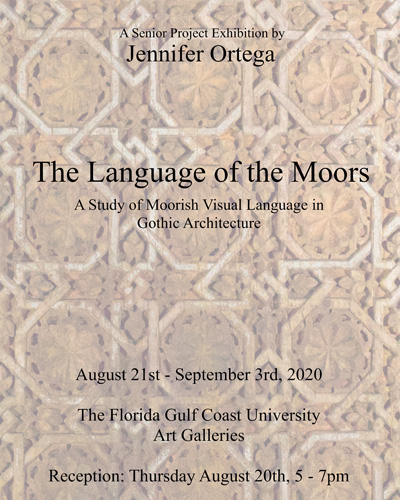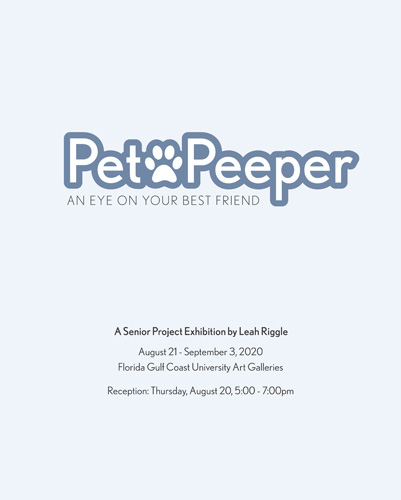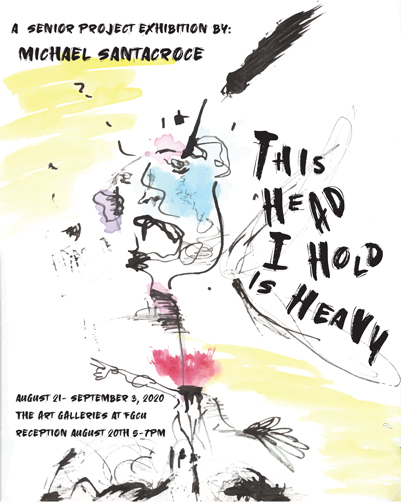
B.A. Art Senior Projects From Spring 2020
Wasmer Art Gallery and ArtLab
August 21 - September 3, 2020
Our first exhibition of the season will celebrate the work of our Spring 2020 Art Major graduates who were unable to exhibit their work in April 2020 due to the COVID-19 outbreak. At the end of their studies, art majors are required to develop and present a coherent body of self-generated work. This exhibition combines their knowledge of techniques and concepts while drawing on research of historical and contemporary artists. Each senior art major in the exhibition designs and creates a unique installation that combines their technical skills and conceptual vision.
Sponsored by The Layden Family Foundation, The Smith Family Foundation of Estero and WGCU Public Media
Image credit: Spring 2019 Senior Projects installations, photo by James Greco
-
Jessa Barone GUARDING THE REALM OF UNCERTAINTY
Toggle More InfoThe alligator is an intelligent beast that has roamed the earth’s lands and waters for more than thirty million years. In its interaction with human civilization, this ancient reptile has been represented by various cultures. In Ancient Egypt, Sobek was a god with the head of a crocodile (a close relative of the alligator) that symbolized power, protection, and fertility; some Ancient Egyptian myths even accredit Sobek with the creation of the world, and with forming the Nile River from his sweat. In the ancient Mayan calendar, an alligator named Imix is the first day sign of the Trecena, a thirteen-day period within the Tzolkin calendar; he symbolized new beginnings for all other day signs to follow, making Imix the catalyst of creation. The Mayans see Imix as owner, guardian, and energy of the water and is referred to as “anima ‘ri cho, anima’ ri plo”, or “spirit of the lagoon, spirit of the sea.”
For as long as I can remember I have had recurring dreams of alligators. They are not nightmares; the creatures are not chasing me or trying to cause me harm. They are just watching, waiting, or gliding atop the water, creating gentle waves with their rough, scaly bodies. In these dreams they appear in a familiar yet distorted place, usually around the canal that is a few hundred feet from my bedroom window. I believe the presence of the alligator is connected to my anxiety disorder, as these dreams always appear when my mental health is at its worst. Although alligators are considered dangerous creatures I consider them my guardians, almost as if they are protecting me from other dangers there may be - even if the danger is myself. My anxiety causes my body to always have to be moving, so sitting still is never an option for me. A method I use to cope with this is to keep my hands busy creating intricate, flowing line drawings. I make these drawings with no conscious thought and let my subconscious take control, as a form of automatism. The intricate, sporadic nature of the drawing represents overthinking from anxiety, while the ritual act of the drawing itself helps me cope with it. In this installation, placing these alligators atop the cloth covered in these drawings puts them in a dream-like realm where they are swimming through these thoughts. Their movement through the environment implies their aid in its formation, and as my guardians their energy guides me through its creation.
My alligators were constructed using a sculpture clay body pushed through a clay extruder using a variety of shaped dies; I would cut the extruded pieces up and assemble them together individually with a slip-and-score method until an alligator is implied from the connection of the various shapes. After assembled and at a leather-hard state, a sand slip with added granular rutile was applied, and the pieces were then once fired to 1945 degrees Fahrenheit. In the center is myself dreaming, and that was constructed with a porcelain clay body by draping a slab over a shaped sandbag. It was covered in a white under-glaze then bisque fired to 1728 degrees; a black under-glaze was applied with a slip trailer and then it was fired again to 1888 degrees. The large floor cloth was fabricated by coating multiple layers of house paint onto a canvas drop cloth, and then sanded down to achieve a smooth surface. The intricate automatic drawing on the cloth was done with black and gray paint markers, and then sealed with a water-based polyurethane. -
Erica Bassett GETTING AWAY WITH MURDER
Toggle More InfoOur home is facing a crisis. Through a surge of land development that shows no signs of stopping, our planet is being overworked for human needs and wants. Legal battles are consistently being lost to save vulnerable, threatened, and endangered plant and animal species throughout Florida. Habitats that should be untouchable for construction are being disregarded by lawmakers. Here in Lee County, Florida we’ve had a rapid escalation in development over the last few decades and we have grown far too accustomed to the sight of construction. Everywhere you go there are dead animals along roads and highways as a result of habitat fragmentation - after their homes are destroyed, they still have to seek food and shelter. During the 20th century the state of Florida alone lost over 7 million acres of land to development and is estimated to lose an additional 7 million in the next 50 years. That’s about a third of Florida’s total land area. What should be priceless is being bought out and it’s only a matter of time before Florida’s biodiversity is gone forever.
Over the last decade I have grown increasingly connected to the natural Florida environment around me. I’ve dedicated my heart and even risked my personal safety, to help sick, injured, or misplaced animals by bringing them to wildlife rehabilitation centers and sanctuaries. While I have always loved the natural world, my connection to Florida’s ecology really began when I was introduced to one of our most unique native species, the North American box turtle. Being able to have them in my life as pets has opened my eyes to what their native habitat has to offer, but also to what is being lost. For my senior project, I chose to use ceramics for its physical qualities and for my growing interest in this medium. I feel that by presenting these animals three-dimensionally the viewer will feel the weight of the situation progressing around us.
Getting Away with Murder is a sculptural installation illustrating the reality of Florida’s habitat fragmentation and its impact on animals. The box turtle figures, made of a white stoneware clay, were initially wheel thrown closed forms, then altered in their leather-hard state. They are left white with some lightly added stains to represent a spiritual presence that I believe is still around us; like ghosts they wander aimlessly through the home they have lost. By crawling up the white gallery walls these forms illustrate the spiritual departure of Florida’s dwindling biodiversity. The roadkill forms were made by rolling out slabs of earthenware which were then altered to take the shape of the broken bodies I see along the roads. They are represented in the red-brown earthenware with some added texture and staining to highlight the bodies that are left on the sides of roads after being hit by oncoming traffic. They are displayed on the low pedestals for viewers to look down on, in both the literal and metaphorical sense. -
Tori Bethea INSTANT EXPOSURE
Toggle More Info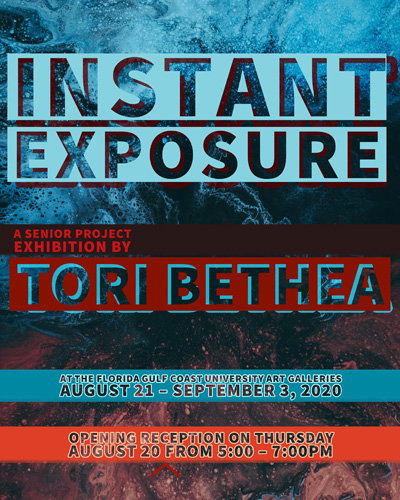
Executive functions of the brain cognitively control our working memory, flexible thinking and inhibitory actions. In people with ADHD, or Attention Deficit Hyperactivity Disorder, the normal process of the brain's executive function is overridden by an automatic response. There are many connections between ADHD and emotional states. The inhibitory actions that would normally calm a person in a moment that requires a response are overridden with impulsive outbursts, aggression, and sadness. This a form of disorder evolves into a sensitized fear of rejection and a heightened need for constant acceptance. There is an inability to separate the difference between a thoughtless comment and a brash insult based on a slight separation between automatic regulating and internal processing. Others misunderstand these outbursts, seeing them as drastic and overreacts which can cause negative effects on personal relationships.
For my senior project I am creating 5 female figure sculpture torso’s to reflect emotions within my personal struggles with ADHD and how it feels when miscommunication disassembles me instantaneously. I chose the torso to reflect a self portrait of the rapid escalation of a negative response. Each figure can be seen as a different emotion that takes place in the process. The first figure is stable, then triggered, becoming angry and descending, before a total collapse. The weight of the pain caused by this misunderstood reflex that overrides a normal function is defined in each torso through carving and line work. The carvings become heavier in depth and definition with each figure, eventually eroding their structure with holes. One by one each female illustrates the message of how the mind can manipulate you into creating your own happiness without proper reasoning.
Instant Exposure is a sculptural composition of 5 female figures in their rising and falling of emotion based on an impulsive reaction to a negative interaction. The figures are built in nearly life size scale. Using sculpture clay with added grog I was able to work fast paced using slab construction techniques. Slabs were stacked and joined using slip and white vinegar to reduce cracking. Once the form was composed and given time to strengthen, I carved elaborate textures using trim tools. My concerns grew with managing the timing processes of drying, glazing and firing. I chose bright, opaque glazes that fade into dark mattes in each step of the descending process. . -
Meg Brunner WHAT MAKES US HUMAN?
Toggle More InfoThe idea of revisiting our past tends to scare most of us. The sentimental parts of our memories that induce a feeling of nostalgia are comforting; when forced to come face to face with the grittier parts of our past, we open ourselves up to the lingering feeling of regret. Regret is a complex cognitive emotion that connects the past with the present, reality with the imaginary, rational with the emotional, and the individual with the collective. Due to this duality, regret is something that both repels and motivates us as humans. Society has inflated our egos to the point where many believe that they need to live out an idealized version of life as seen on their screens. The fear of missed opportunities forces our subconscious to pick the safer path in life. Therefore, when put in situations that are beyond our control, people tend to feel regret at a much more intense capacity. Statistically, more than 90% of people will experience some sort of major regret in their life. The feeling is paralyzing, it leads to excessive hesitation and self-doubt preventing people from re-engaging with life.
Growing up I’ve always felt an enormous amount of pressure to please everyone around me. I found myself desperately trying to fit this romanticized version of reality that was forced down my throat. However, no matter how hard I tried I was constantly told I was never good enough. This overwhelming feeling of disappointing people has made me a perfectionist to a fault. This ultimately has led to an immense amount of regret that has manifested itself into a never-ending cycle of anxiety and depression. As a result, I spend most of my days going through an existential crisis reliving the past, unhappy with my present, and completely terrified of my future. It’s isolating; feeling like every decision I make is ultimately going to end in failure. Everything I had always envisioned that would make me happy left me feeling empty, and I let myself get taken advantage of in order to satisfy the needs of everyone else. Once I immersed myself into different creative outlets, I realized I wasn’t alone in feeling this way. I suddenly felt human again. All of these suppressed memories of past regrets gave me a sense of vulnerability that broke me out of the robotic mindset I was in. My project was made to provide a platform where people felt safe to fully confront their past and find a sense of comfort from these experiences.
For my exhibition, I’ve created transparent collages that visually narrate the feeling of regret through my own stories as well as anonymous stories that I’ve collected through a variety of peers. I chose to work with collage so that I could explore the idea of building up different mediums to symbolize how we as humans are comprised of layers both figuratively and literally. We aren’t just skin and bones, we are a collection of different parts that come together to create what we know as being human, which is the overall essence of my project. Through the combination of photos, text, and gestural mark-making, layers form to emphasize each respective narrative. The photographs and text work together to represent the visual aspect of fragments of our memories. I have also included transparencies made using a technique similar to monotype prints; expressing the notion that they are one of one and cannot be recreated, just like moments in our lives. The gestural marks also represent the nontangible feeling that these regrets evoke within us. All of these pieces are collaged together between plexiglass creating the illusion that the piece is floating off the wall. This allows a greater interaction with light which will highlight the transparent nature of the piece, which symbolizes exposing he most vulnerable sides of ourselves. My series at its core represents that while no one ever goes through the exact same experiences, we are able to connect with others through shared similarities of these instances and the emotions felt, and to understand that you don’t need to live without regrets but rather learn to live with them.
-
Matthew R. Burge SUNNYLAND
Toggle More Info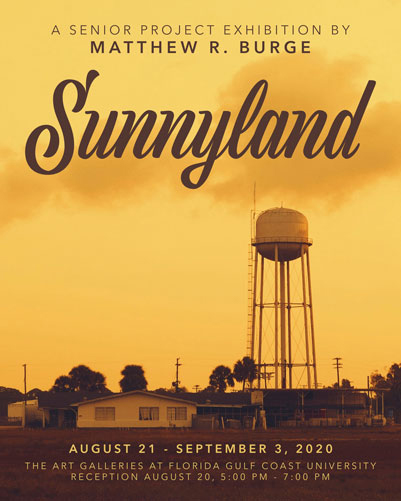
“Film has dream, film has music. No form of art goes beyond ordinary consciousness as film does, straight to our emotions, deep into the twilight room of the soul.”
—Ingmar Bergman
Places are like people: some forget the past, but others don’t. Buildings house the lives, thoughts, words, and deeds of the people who find themselves dwelling in them. They are witnesses to things seen and unseen: a baby’s first steps, a student’s college acceptance, a volatile fight, a couple’s warm embrace, the splitting of a family, a proposal, a diagnosis, a heartbreaking loss. The Buckingham Complex, a former mental rehabilitation center that Florida Gulf Coast University acquired in 2010, is one such place. Originally opened in 1960 as Sunland Training Center, Buckingham has become a relic of past antiquated and inhumane practices for the intellectually disabled. The history of Buckingham has been kept alive in the mind of one man, Dennis Nourse. Mr. Nourse is the primary caretaker of the grounds today, and through his stories of what happened while he served as an administrator of the complex, I have been able to gain insight into its history.
Storytelling is a part of who we are as human beings. We tell multiple stories to numerous people each day. By storytelling through film, directors are able to elevate the impact and reality of these stories in ways that are unique to film. Movies invite audiences into themselves, just the same as any painting by Edward Hopper or Edgar Degas, but with some key distinctions. Film utilizes sight, sound, and movement to envelope the viewer in a complete sensory experience. This is also what differentiates film from theatre, where the viewer is constrained to one location. Instead, they may move in as many ways and explore as many worlds as the filmmaker wants them too. Film is also edited; the viewer sees only what the filmmaker wants them to see. The art of manipulation is part of the essence of film. Through purposeful aesthetic choices such as the employment of one-point perspectives, deliberate linear camera movements, and the use of inventive lighting techniques in the vein of Orson Welles, I have accurately reproduced the tangibility of the Buckingham location and shared what is a unique story.
My process began by visiting the complex and taking hundreds of reference photos for the locations that I would use to build my story. This was an instance of creating a story for the location, versus finding a location for the story. Over the next few months I made numerous trips to Buckingham to develop the project, knowing that the complex itself was a character in this story. After writing the script, an in-depth screenplay was developed where I storyboarded all of the shots that I needed. Lastly, I recruited two actors and met with them to discuss the schedule and process. When it came time to begin filming, I used a Panasonic 4K Lumix GH5 camera, employing multiple lenses for various scenes. I used natural light along with Arri light kits provided by FGCU’s video marketing department and a Dynaphos light kit from FGCU’s Art Program. All of the post-production editing was done on an Apple Mac Pro and completed using Premiere Pro from the Adobe Creative Cloud. To fit the somber mood of the film, I used music by several early 20th century classical composers. Sound effects were created in-house or acquired from royalty-free sound effects websites. -
Francheska Castano THE ETERNAL SPRING
Toggle More InfoOur surroundings have a profound influence on our behaviors, our lives, and our state of mind. I was influenced by a united and proud family who have learned to survive and cherish their lands while maintaining unconditional love. The surrounding environment is what gives my family the means to live, grow, gather, and express themselves. This environment is where I flourished. Colombia was not my birthplace, but it feels as if I was. Most of my fond memories were born within the once small town of San Antonio De Prado; a town my own family helped to build through their own labor. As years passed, this familial and natural landscape began to deteriorate. What my family knew to be the small town the resided in, became a place of unregulated urban and agricultural sprawl that has rendered areas unbearable and toxic to live in. The founders and original settlers left for better opportunities or to get away from violence, and people who replaced them were people unfamiliar with the way of life. Accompanied by the passage of time, came the death of elders and aging of the newer generations who seem to grow farther apart. Trying to recall how everything was becomes more emotionally difficult. The good nostalgia of the past quickly transforms into a hollow sentiment.
As a first generation American, I was expected to not appreciate where I was from, but it became the opposite. I identified with the rest of my family, a proud “Pradeño.” Every moment with my family played a part in my growth, from the warm windy days walking the streets, to the cold nights spent in the Finca surrounding a pit fire where we cooked the most delicious soup I have ever tasted. For The Eternal Spring, I wanted to compile some of the many memories that I have being there. These times are slowly becoming less frequent because responsibilities and places change. The Finca which I held close to my heart has been destroyed and is no longer in the family’s hands and the familial schedule is being occupied by other errands. The Eternal Spring was created to preserve the beauty of these moments and settings that what once were. I chose to create this triptych as a painting because through paint I can emphasize the vibrancy of the landscape, communicate an emotional connection, and capture my vivid memories in one place. Through this painting I remind myself of the good and maintain hope that these memories and places will be restored.
The Eternal Spring is an homage to a lost paradise which holds memories within the landscape. The painting is an acrylic triptych of my father’s old Finca called “La Zelva.” The whole painting is separated into three 30x48 canvases that can be displayed separate or together. The painting is a recreation of the atmosphere and feeling that was present in a moment in time that I vividly remember. I gathered oral histories, stories, and family pictures to help in recapturing the setting. I created small and full-scale drawn or painted studies in order to map the composition of that lost paradise. Every blade of grass, tree, building, and person is essential to the nostalgic atmosphere of the piece. Through the use of color, the landscape will appear as a hidden land separate from the rest of the town to keep it as a precious memory and embrace the nostalgia that comes with the thought of it. -
Mya Hesby SCALE OF SPACE
Toggle More Info“Remember to look up at the stars and not down at your feet. Try to make sense of what you see and wonder about what makes the universe exist. Be curious. And however difficult life may seem, there is always something you can do and succeed at. It matters that you don't just give up.”
~ Stephen Hawking
Scale is a concept that can be applied to numerous areas of life. Space itself is a keystone example of this notion, especially regarding relativity in size. At times we as humans feel large and empowered, and at others feel small and rather helpless. However, there is so much more out there on a grander scale, which for us, begins here in our solar system. When we look into the night sky, the millions of stars present remind us of all that is in our galaxy besides ourselves. And when that thought seems overwhelming, the knowledge of the two trillion galaxies present in the universe looms our rather small world. Humans have been intrigued with space since the beginning of our existence. It is this wonder, curiosity, and ambition that drives us to explore it.
My initiative to create this exhibition stems from my fascination with the imagery of space and how I am able to portray three of the most massive examples of size in their own, distinct way. Having a life-long passion for sewing and fashion design, as well as an affinity for space, I chose to merge these two interests into one body of work. Through the use of colors and patterns, each garment embodies the key elements of the source it is portraying. I have always found that the way I am most effective in conveying my creative vision is through the construction of garments. I had a plethora of inspiration when creating these dresses because of the various unique colors, patterns, and shapes that are present in astronomical objects. The translation of one recognizable thing into a completely different format is a process I have long been fascinated with exploring.
The design process begins by observing the distinct colors, shapes, patterns, and overall essence of my inspiration source. I then flatten and simplify these elements in my mind, and begin to envision them coming together in the format of a garment to be worn on the human body. I create sketches of the designs and begin patternmaking, then proceed to the actual construction of the garment. By incorporating the most distinguishing qualities, the clothing piece is reminiscent of its original source. A vast array of materials and methods were used in the creation of these three garments. Tulle and chiffon has been layered to create a feeling of infinity. Beads, sequins, and other embellishments adorn the fabrics to create intricate shapes and patterns, reminiscent of stars and galaxies. Dynamic forms are present in the dresses through the combination of various fabrics, as well as by gathering and pleating techniques. Each dress is displayed with a source image of its inspiration, as well as with a photo of it being modeled. -
Sheena Heuer ASTERI
Toggle More Info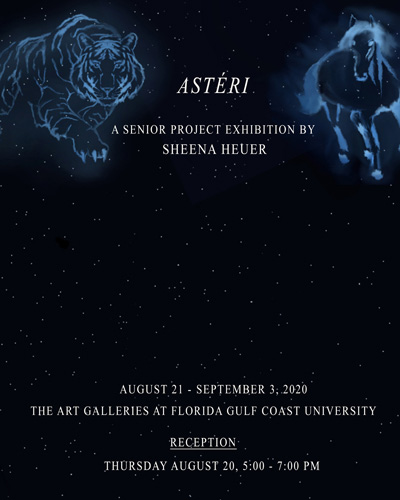
“I don’t know anything with certainty, but seeing the stars makes me dream.”
~ Vincent Van Gogh
Watching the stars from the earth below has always been a form of guidance for humankind. Travelers across the globe relied on Polaris or the North Star, as a compass to their destination because the star does not appear to move. The first documented astronomical observation began with early civilizations of Mesopotamia after 3000 BC. The ancient Egyptians contributed the idea that star patterns created constellations. The Babylonians, a Southern Mesopotamian people who flourished approximately 1900 BC, were the first to apply myths and stories to constellations and astrology. The term “astrology”, as well as the science of astrology, is derived from the Greek word for star, astéri. Many of these early constellations took the form of animals. Spirit animals were thought to be gods, familiars, or totems that represent a powerful connection to the spirit realm.
I have found that the stars have been my solace in distressing times. As I gaze upon the stars, I feel I am being watched over by spirits from the cosmic realm. There are eight main spirit animals who are active in my life. Based on knowledge from other cultures and inspirations, I have developed names for these constellations. They are the deer, the tiger, the horse, the owl, the lioness, the wolf, the bear, and the alligator. Abriel the deer teaches me to be gentle with myself. Stella the tiger gives me the freedom and courage I need. Isaiah the horse guides me to become the true embodiment of who I am. Abu the owl reminds me knowledge is keen to the eye. Adorah the lioness is the strength I possess and the strength I need to overcome my fears. Rosaline the wolf influences which steps I take in the future. Mazu the bear is the protection I seek and Crok the alligator reminds me to take care of my body and spirit. Illustrating these spirits is my way of better understanding who they are and what their purpose is in my life. I have created them as star constellations because I imagine their bodies to be in the form of stars.
I start off drawing the animals using traditional media in order to develop the imagery. They are sketched with pencil and lightly painted over with acrylic. The process of adding and removing details is done by layering acrylic paints and adding soft, pastel colors. Once I feel I have developed the imagery enough, I then transition to the digital platform by using the Sketchbook software program and my Wacom art tablet to create these animals digitally. The digital process is similar to the traditional process by adding and subtracting details from the animal’s body. I use a soft brush to blend the colors together and create a cloud texture around the form. After I finish the animal imagery, I thoroughly plan how the star constellations should form within the animal. I then transition to another program, After Effects, to animate these images by having their constellations and abstract details slowly appear in the sky.
-
Kaitlyn Hynoski WE WILL BE HEARD
Toggle More InfoThroughout human history, women have consistently dealt with issues regarding personal safety, gender discrimination, and harassment that have continued to the present. According to the US National Sexual Violence Research Center, one in three women will experience some kind of sexual violence and one in five women will be raped at some point in their lives. In the majority of rape cases, the victim knows the person committing the violence. Rape and sexual violence are not only physically damaging, but also mentally scarring, as 81% of women who report their assaults also report some form of post-traumatic stress disorder. Despite access to counseling and other ways of coming forward, women are still afraid of facing the pattern of victim blaming that often occurs when seeking support for their trauma.
This senior project was created to emphasize and shed light on the topic of rape and sexual assault on women, specifically focusing on the inner turmoil victims suffer as a result of sexual assault. I chose to emphasize the inner battle someone who has been assaulted may be fighting and the healing stages they endure afterwards. Speaking out as a survivor myself, I know that it is extremely challenging and takes a lot of strength to seek support from those who may not understand entirely what victims are going through. It is hard for others to fully comprehend the internal processing stage after experiencing an act so vile. When I moved away to college, it was exactly one year after my own rape. I felt alone and scared. My family was my security blanket and I had left them hours away. The nightmares I had about the assault intensified and were happening more frequently. I turned to sketching as a way of coping with my own trauma and I began to seek refuge in creating art. This became so deeply rooted and made me feel more like myself again. I was able to turn my trauma into an even more passionate career path. This project is meant to not only publicly fulfill my mental coping strategy, but also to help other who may be experiencing the same trauma.
We Will Be Heard is an installation of two large-scale fabric panels comprised of illustrations and typographic pieces based on collected stories from victims of sexual abuse and rape. Using watercolor paper, black India ink, and watercolor paints as the primary materials, each illustration was created by hand and was conceptualized based on the stories provided by anonymous survivor entries. I scanned each individual drawing into Adobe Illustrator for digital editing. I scaled the illustrations to the size best fit for each powerful story and finalized the images in Adobe Illustrator. The first panel is to be read from top to bottom to reflect the disintegration of the mental state of a rape victim and the feeling of sinking and deterioration. The second panel is meant to be read bottom to top to reflect the reestablishment of the victim’s health and mental stability and the feeling of rejuvenation and self-worth. These illustrations were printed onto fabric meant to symbolically represent bed sheets. The bed sheets are a recognizable symbol of comfort to many, but to others, they are a reminder of torture endured. -
Lacey Irene TRYING TO COME TO THE SURFACE
Toggle More Info“The mind, placed before any kind of difficulty, can find an ideal outlet in the absurd. Accommodation to the absurd readmits adults to the mysterious realm inhabited by children.”
~ Andre Breton
According to Andre Breton’s philosophy as stated in the Surrealist Manifesto (1924), pure psychic automatism dictates the state of our thoughts, our feelings and even our dreams. Many Surrealists held onto this theory of freeing one's mind of rational thinking by experimenting with unusual juxtapositions of the figure and their environment. Allowing oneself to fully let go of the constraints of reasoning, and moral and aesthetic concerns, was a driving force for the Surrealist movement. The Surrealists relied on different techniques from automatic writing to frottage (the process of rubbing onto a raised surface to create textures) to spark their evolutionary process of their work. Unveiling the cover that shields our eyes from the expansion of our minds helps strip away the constraints that the Surrealist opposed. Looking at the world with curiosity is something that was innately built into my psyche at a very young age. As children we see the world with a clear lens because we haven’t been shaped in such a way to taint our experience with reality.
The last several years I have had a recurring dream, which has ultimately inspired me to make this body of work. Soft billowing pastel clouds hug disjointed figures in the sky, while soaring birds, a pool of water, and a red cardinal float in the vast open space of my subconscious thoughts. These images create the foundation for my ever-evolving “waking dream”. My intention for my senior project is to expand upon the story that begins when I fall asleep at night. To help restore the missing pieces that encapsulate these figures, I am displacing them from their original context to create a new narrative that reflects the pure state of their being. Constructing these five representations of my recurring dream is a meditative process for me. I am able to remove myself from the rigidity of life and step into a state of dream-like wonder. My hope is to encourage the viewer to never lose their childlike curiosity with the expanding world we live in, even through our obscure subconscious dreams.
I'm Trying To Come To The Surface is a collaged assemblage of different scenes based on my reoccurring dream. Using watercolor, ink pen, Prismacolor, and different clippings from old magazines and books I am able to contextualize the richness of this multilayered and metaphysical experience. Before I constructed each layer of the composition, I drew out detailed sketches and made movable paper dolls of the individual figures. I then accumulated found books and magazines and cut out images and layered them on top of each other. Working methodically to organize the background, middle and foreground opened a door for cohesion for the figure and the objects. I moved these elements around to establish visual order throughout the composition before I used an adhesive to make it permanent. To emphasize the illusion of space and how this “waking dream” is interacting with the outside world, a few elements throughout each composition are raised with a 1” mat board square and stacked to create an elevated surface. When I finished compiling these raised-relief collages, I used my own poetry and automatic writing to integrate a deeper narrative for the conceptual worlds I'm creating. -
Lili Iriarte ANIMALS
Toggle More Info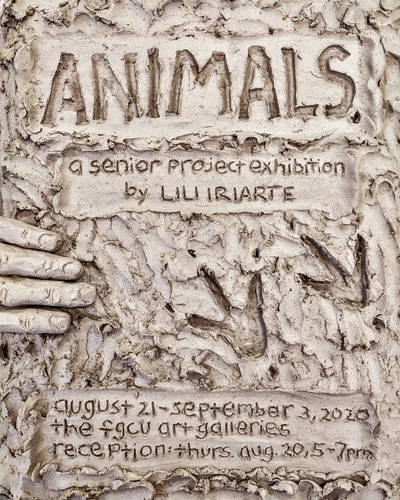
Over the last three generations, there has been a sudden shift in the human relationship to nature. A personal and emotional understanding of the natural world through the senses is being replaced with a different kind of picture, one that is predominantly logical and intellectual. In order to comprehend our relationships to the planet to the fullest extent, we need to make both emotional and intellectual connections. It is a false utopia in which children learn about nature strictly from a sterile, plastic-wrapped place where they are kept safe? A child who can perfectly recite the stages of the water cycle but has never played in the rain is missing something critical in her education. When personal, emotional contact with nature is lost, so is a very large piece of what it means to be human. In order to convince the world to actively protect the earth, we need to remind everyone that humans are animals, animals are nature and any threats to nature should be taken personally.
My understanding of the world has been shaped by a childhood spent mixed in with the lives of animals. Each one, their own universe, had so much to teach me about living and dying. I sat with them quietly and learned about their complicated social lives. I watched my rooster grow up and fall in love with a little yellow hen who was unimpressed by his constant offerings of unearthed, wriggly bits of food. I cried, brokenhearted and guilty upon discovering that the coop I put them in was not enough to protect them from an unknown hunter. My extraordinarily aggressive duck provided me endless entertainment with his bold moves for authority over the dog. A cheap magnifying glass revealed to me the secret society of determined little red ants and their efficient communication systems until I was discovered and bitten by ten of them in a coordinated onslaught. I’ve seen a love as real as any between my big brother and his dog. My mom took time and effort to heal a baby frog’s broken leg. Animals remind us what it means to be human because the definitions of human and animal overlap much more often than not. We’ve gotten lost in a world built of logic and reason, but animals can help remind us of what we are at our core.
This series of seven pairs of humans and animals were hand built from raku clay. Each pair began with the story of an animal who I have met, and their intersection with the lives of my friends, my family and myself. I articulated these stories through the figure, combining body language in sculpture and written language in the titles. The human and animal figures were hand built with various methods including the use of slabs, coils and carving. They were then cut in half, carved out and joined back together so that they would be self-supporting, hollow forms. I used as few tools as possible to shape the clay figures and allowed the texture that comes about naturally from working the material with my hands to remain. Many of the small details did require the use of pointed, wooden and rubber tipped tools. Initial coloring was added with underglaze, then bisque-fired in the electric kiln to 1728°F. They were then inlayed with black underglaze to emphasize the surface texture and lightly glazed, and fired again to 1888°F. -
Kathryn Johnston AN UNFAMILIAR EPOCH
Toggle More Info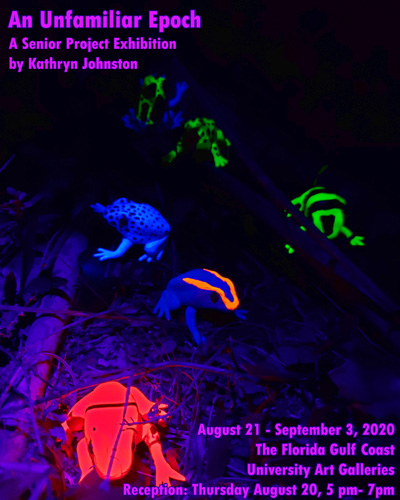
One hundred and fifty thousand years from now, our planet might look very different. Humans are making irreversible changes to our environment though habitat destruction, the release of chlorofluorocarbons, and global climate change. As a result, we live in a geological epoch with the proposed designation of “The Anthropocene”, or the Human Era. Animals have already been forced to adapt or become extinct, and many animal species have been driven to extinction. Others however have been able to adapt to thrive in a landscape that has been changed. Peregrine falcons make nests on skyscrapers and raccoons flourish in the alleys of cities. Coyotes prowl neighborhoods at night, feasting on unfortunate wild animals and pets left outside. As humans continue to shape and change the world, other animals will be forced to change their appearance and mannerisms to adapt or risk disappearing. They will have to overcome challenges presented by their rapidly changing environment, but if they can make it through and adapt, they will inherit a new world.
For my senior project I chose to focus on this idea of creatures adapting to a changed environment. I decided to focus on creatures that personally interest me and that I could imagine surviving and thriving in the environments of the future. I imagine an environment where there is more UV light due to a partially depleted ozone layer, and animals that must have adapted to this change. Dart frogs develop a powerful toxin from eating ants for defense and are naturally colorful to advertise their inedible status. Their displays and size may become even grander with adaptation to UV light, so their inclusion was natural for me. Chickens exist everywhere there are humans and are descended from mighty dinosaurs. There are already feral chickens, so it is only reasonable that chickens could continue to adapt to living in the wild, finding food, running around, attracting mates, and opportunistically eating things like frog eggs.
I have chosen to use fluorescent paint to represent adaptations brought on by increased presence of UV light. Each of the more than 50 dart frogs was made with polymer clay, baked, and then painted with acrylic and fluorescent paint to look like real dart frogs. The water in which these frogs spawn is made of glowing tonic water and the eggs are made of water beads, which are semitransparent in water much like real eggs. The chickens are created from paper clay and polymer clay on an aluminum armature. This base was then feathered with paper feathers, and finally painted with the same UV paint the frogs are coated in so that they too have a fluorescent display, used for attracting mates much like modern birds of paradise.
-
Jennifer Ortega THE LANGUAGE OF THE MOORS
Toggle More InfoThe Islamic invaders conquered Spain in 711 and infused their visual language into the architecture of the country. This moment in history would shape future architecture styles from the Romanesque to the revival of the Mozarabic architecture in the mid-ninetieth century, and influence the Gothic period in Spain. The Moors contribution in architecture was the delivery of new forms of composition, open spaces, planned gardens including the flow of water, lavish pattern and colorful designs. Furthermore, the horseshoe arches and slender columns, a common trait associated with the Moors, can be found in Southern Spain during the period of occupation and after the fall of the Islamic invaders. Despite the fall of the Moors in Spain, Gothic architecture continued to carry symphonies of rhythmic visual language of Islamic features. Though influenced by the French Gothic architecture, the Spanish Gothic architecture carried its own flavor of composition. The resurgence of style in the Gothic period can indicate how Spain was visually disturbed by the new forms and inspired to find new ways to retell the same formula.
In the quest to find my own heritage, which originates in Spain, I came across a labyrinth of architecture and art that sang to me. I find interwoven in Spanish architecture traces of Islamic origins. One moment in time stood out to me the most, the Umayyad’s invasion of Spain. My newfound curiosity for the unknown, the unwanted, and the misunderstood about Islam as a religion, its people, and the great devotion that supersedes the human realm, led me down a new path. This new path would produce more questions than answers, whilst attempting to answer the question, what is my purpose in life? My fascination with finding answers about myself and about religion led me to take a college course in World Religions. The college course brought me a little closer to finding answers, but it too posed more questions. I found myself inquiring about the gravitas and clout of religion - how Islam was able to invade, convert, and influence Spain, and how religion could change the course of history and have a lasting effect on the culture it resides in. Despite the fall of the Moors, we see the echoes of their influence in architecture.
My journey and my curiosity to show the importance of the Invasion from the South was to Spain will be best answered using the visual language of key Moorish and Gothic architectural photography. The juxtaposition in style and timeline, and the reinvention and usage of Moorish features in Gothic architecture, will be further explored in a research paper. The research paper will encompass all ruling Islamic Dynasties in Spain, beginning with the Umayyad Dynasty till the fall of the last stronghold of Nasrid Dynasty in Granada. The dissimilarities and influences in style will be exhibited using central features of the building’s composition shown in print and organized vertically, with the left side including Moorish architecture detail and the right, Gothic reinventions of Moorish architecture features. -
Leah Riggle PET PEEPER
Toggle More InfoThe interspecies bond between a human and its pet is remarkable and incorruptible. Documented since 7000 B.C., we as humans have desired the companionship of animals—to which we now refer to as pets. Historically, dogs were used strictly for hunting, herding or fighting for social statuses. Collars were invented to protect the dog wearing it, but hurt dogs attacking it. As time progressed, dogs and cats were used as a symbol of political power and royalty—with only the rich owning them. Today, dogs and cats are celebrated as our companions. Whether they are utilized for herding, law enforcement, or simply the sake of having that special bond, pets have remained a staple in households around the globe. The connection between a pet and its owner is unbreakable and exemplifies the meaning of true, unconditional love. An owner takes on a maternal or paternal role and thus comprises the entirety of a universe through a pet’s eyes, and without their owner, a pet has no safety net.
My inspiration for my senior project comes from my fascination with domestic companions and their reliance on me to protect them from this world and its cruelty. I’ve brought in numerous animals with special needs throughout my life, as well as some perfectly healthy but generally “needy” ones. I take them into consideration with my daily routines. However, this isn’t an option for everyone. It can be difficult being the only one in a household with a young, new, or disabled pet at home always waiting for you. There’s an abundantly strong sense of guilt and anxiety that you feel when leaving your pet somewhere for extended periods of time. A nurturing aspect comes out, as if they are your children. You desire to do everything in your power to care for them to the best of your ability. With many people working more and more, including myself, our pets deserve an extra hand when we are away. I believe people deserve to have pets, not only for the animal but also for themselves. Even if you need to be away from home at times, a pet can change your entire life. Pets have proven to be uplifting in our own mental health. Without my pets, I couldn’t say that I’d be here today. It was those nights when I held them close to me that truly impacted my life and reminded me that there’s much more to this world than just myself. My pets need me, and I need them as well. I will do everything in my power to give them a safe and loving home.
The process for developing my senior project was not a simple one. It involved extensive research on what was and wasn’t a legitimate possibility, as well as what would be beneficial to the owner without being too confusing for the owner. I wanted the app to be clean and legible, while remaining complex and versatile. Sketching was the first process to every aspect of the project. A clay model of the Pet Peeper collar was sculpted and measured carefully to ensure proper fitment for my mannequins. Final designs and measurements were sent to an engineer for 3D printing, and everything else was carefully created with Adobe software, then printed. Every part of this project needed to follow the branding I created, in order to keep a sense consistency clarity. Ultimately, this project allowed me to understand that we will never truly know everything about our pets, but Pet Peeper allows us to get significantly closer. -
Michael Santacroce THIS HEAD I HOLD IS HEAVY
Toggle More InfoThere’s a preconceived notion that happiness seems to be the only mood that is socially acceptable, yet it is the hardest one to authentically create. Being human, we often seek ways to stimulate happiness regardless of the consequences. This pursuit of happiness leads many down the destructive path of addiction. At its core, addiction can take on many forms. There’s no specific demographic of what or who makes up an addict. Anything that somebody does to an excessive amount can create addictive tendencies. People often jump from one addiction to another in order to satisfy the permanent aching in their hearts. It strongly impacts the brain's ability to produce dopamine, which is responsible for stimulation, emotion, and cognition. Addiction deteriorates a user both physically and mentally through years of repeated abuse, and for some it destroys the very idea of happiness.
For the past two years I was shooting toxins into my veins, drinking heavily, and mindlessly having sex with strangers as a coping mechanism for my own internalized self-hatred and depression. Nobody in my life knew what was going on behind closed doors until I took a trip to the ER last summer that brought my addiction out in the open. The process of creating art then became therapeutic for me to clear all the negativity from my mind and bring me a sense of closure. The purpose of my exhibition is to communicate a strong personal message of vulnerability, honesty, and self-preservation to the audience. The artwork serves as a medium to communicate a discussion on the struggles that people often battle silently. My struggles with addiction could have ended if I had sought help instead of feeling ashamed and keeping these problems to myself. The images in the exhibition represent the voice that I often hold back in my head whenever I’m around others and it screams out for the attention of those who choose to acknowledge it. The demons found in my work present an abstract self-portrait deriving from my subconscious, focusing on the emotional and internal struggles that I’ve faced.
In order to symbolize the chaos that goes on inside my mind, the exhibition is primarily composed of poetry, ink drawings and relief prints that characterize a stream of consciousness. Through this method of creating work, I emphasize line and shape to automatically capture my thoughts and emotions. The method of carving in the relief-style becomes automatic and fuels the expressive linework of my inner-demons. My work is presented as a collage made up of torn images and scattered text that reaches the top walls of the gallery to symbolize the sheer magnitude that these thoughts occupy in my head. The giant wooden head appears without a body to emphasize to the viewer that addiction is a battle of the mind and that the struggles I faced were larger than what was physically in front of me. Similar to the story of my addiction, I cannot take back what I have already done to myself, but I can create a better future. The mistakes made then transform into beauty and resilience, as they emphasize that life is full of them. -
Megan Shinham INBOX
Toggle More Info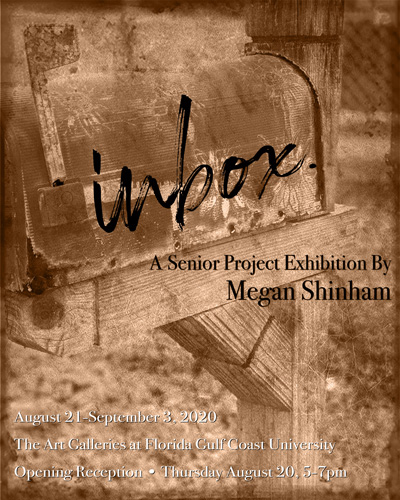
Through the intricacies of transferring words from mind to paper, human beings create and send letters that share their complex feelings for one another. Before the invention of the telephone, letter writing was the world’s main source of long-distance communication. With the introduction of electronic communication i.e. phone calls, emails, and text messages the ease of interaction was faster and more convenient for people, directly causing a decline in the number of letters written and exchanged. Today, 60 percent of adults have sent less than five handwritten letters in the past decade, while 6 percent have not sent or received a letter at all during this period. When writing letters, one is meticulous and thoughtful. The receiver of a letter can view every crossed-out word or erased mark showing how carefully the writer considered each individual phrase. The steps taken to write, address, and mail a letter emphasize its intent to form and strengthen the bond between people.
In December 2019, my mother showed me a box filled with family history, including multiple generations of photographs and letters. The box was labeled “Please NEVER destroy these. Save for your Grand Children. Read sometime to know what love is all about.” This box and its contents both inspired my senior project and were used within the works you see today. By looking through the box of letters, I was reintroduced to certain family members who had passed away and could feel their intense emotions during important life events through their writing. I believe that writing a personalized letter to someone, and the process it takes, truly shows how much the writer cares for the recipient of the letter. Letter writing, in my opinion, is a more meaningful form of contact than communicating with technology. When you receive a letter, you receive a tangible memory to hold on to. Letters are intimate, deliberate, and specific to the person. Letter writing is a form of communication that should not be lost.
My senior project, INBOX, consists of ten solar plate prints that depict the collected letters I felt the most drawn to and the archival images of the people involved in these letters. By using the solar plate process, I have taken the letters and photographs that I’ve gathered and combined them digitally, further preserving them through the hands-on method of printmaking. The first set of 5 plates pull inspiration from my family’s letters, and the next five include letters I have written to the people in my family who are important to me. By implementing this element my series gains the connection from writing in the past to writing in the present. I elected to print the plates in a sepia tone to pay homage to archival photography and letter writing of the past. By layering the letter with the archival imagery, I am able to blend the two, symbolizing the connection the letter has to a moment or memory. This project has shown me the importance of letter writing and I encourage you to communicate to your loved ones through writing one another. -
Tanner Yorchuck STORM SQUAD
Toggle More Info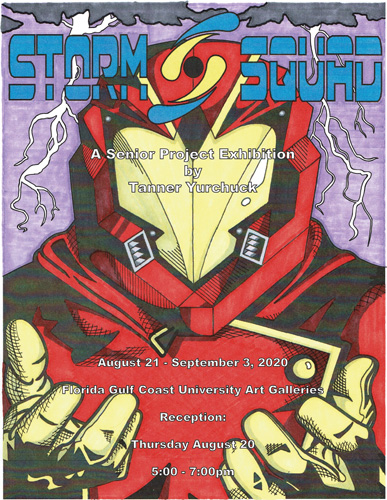
A comic book is a great way to visualize a parallel universe with different politics, locations, history, and social environments. For my senior project titled Storm Squad, the comic praises the abilities of everyday heroes rather than focusing on mythological champions with fantastic superpowers. These heroes are meant to be relatable to the reader who will be able to identify themselves in at least one of these characters. With trying times both at home and abroad, I chose to highlight the heroic abilities of active service men and women, because of the sacrifices they make for us to live free. There are many diverse inhabitants and struggles that my Storm Squad must face in this world to make it a better place for everyone. A comic book has always been a way to grapple with issues of crime, terrorism, and war. My heroes prevent acts of terror from foreign powers and international terrorist groups, such as that of Phoenix, the main adversary of Storm Squad.
My paintings and book illustrations are all rooted in growing up reading comic books and playing videogames. I have been developing different ideas for Storm Squad for several years with my longtime friend Ralph Perkins, who assisted in writing the dialogue for the comic. My main influence was growing up in a great family made up of military veterans, police officers, firefighters, paramedics, nurses, and civil servants. I see both my mother and father as heroes, for the risks that they take every day and night to keep everyone safe. My parents are two of the many heroes that I have made Storm Squad for, and I hope that the book inspires others to create their own stories with imaginative characters and worlds that share their outlook and point of view.
Storm Squad (Issue #1) is a forty-page comic book comprised of hand-drawn illustrations of the soldiers and the setting of Empire City, a fictional representation of New York City. This “Marvel Style” of illustration was developed when comic books were first created. With the use of character studies, I identified significant body features and facial expressions to draw after storyboarding the narrative. Each of the panels is created first by sketching with pencil, followed by fine liners and ink, filling them in with alcohol-based markers, and then revisiting them with fine liners for the extra shading effects. The comic book pages are then scanned into the computer to be touched up and altered if needed, then resized to 7 in. x 10 in. The formatting and alterations take place in Adobe Illustrator and are sent as PDF files to Mixam.com to be printed. Along with the comic book I have created a triptych of 30 in. x 48 in. canvases including a replica of the cover of Storm Squad (Issue #1), and two paintings that help visualize the world that I created. The process of painting is sketching with pencil, establishing the linework with black acrylic paint, filling the shapes with the appropriate colors, and revisiting the outlines with black. I also include black and white character studies on 8x11 foam core panels which have been illustrated with fine liners and ink to show the process of creation.
Video by Dale Ward

